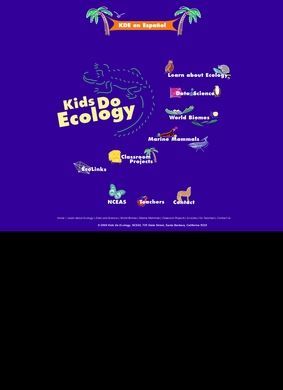Kids Do Ecology, a product of the National Center for Ecological Analysis and Synthesis (NCEAS), is an engaging, accessible platform aimed at providing educative content on ecology to younger audiences. The website combines scientific insights with interactive elements, striking a balance between enjoyment and education.
The site features a well-structured menu, dividing the content into 'Learn about Ecology,' 'Data and Science,' 'World Biomes,' 'Marine Mammals,' 'Classroom Projects,' and 'EcoLinks.' The ease of navigation and coherent organization of these sections enhances the platform's user-friendliness, facilitating efficient exploration for a young audience.
The 'Learn about Ecology' section is a comprehensive repository of information on ecological concepts, compiled in digestible formats. Infographics, illustrations, and simple language cater to different learning styles, making the content accessible and engaging for children.
In the 'Data and Science' section, the website deals with complex theories and ecological phenomenons with clarity and brevity. The usage of visual content helps demystify intricate concepts, rendering the information palatable for a young demographic.
Through the 'World Biomes' and 'Marine Mammals' sections, the website expands the study arena beyond terrestrial flora and fauna, providing an encyclopedic overview of diverse habitats and various aquatic species. The panoramic coverage educates children about the significance and peculiarity of different ecosystems and their inhabitants.
'Classroom Projects' and 'EcoLinks' sections encourage active participation and exploration. The ready-to-use project ideas stimulate practical and experiential learning, while the links to other ecology-focused resources foster expanded learning.
The 'For Teachers' section serves as a profound tool for educators. It equips them with learning supplements like lesson plans and classroom activities, further bolstering the platform's educational value.
Despite its prowess, the site has a few shortcomings. The interface can occasionally feel outdated, and the engagement levels could be propelled higher by embracing more dynamic, modern elements like animations and interactive games. The contact information for the platform is accessible but appears incidental rather than integrated, slightly affecting the cohesive design of the site.
In conclusion, Kids Do Ecology, based in Santa Barbara, California, succeeds in simplifying and presenting ecological principles in a format that is captivating and age-appropriate for children. Its strategic balance between fun and learning, along with a comprehensive blend of theory and practicality, makes it a valuable resource for juveniles interested in ecology, as well as for educators seeking rich content for lessons. However, it could benefit from certain enhancements to boost its appeal further.
